Dania Berinde
Once upon a time, before Alexander Fleming discovered antibiotics, herbs, plants and spices were used as a mean of treatment for various illnesses. The discovery of these came rather accidentally with the prehistoric man wrapping the meat in different leaves taken from bushes and thus realizing that the taste has changed. But the property of plants and herbs don’t stop here, it goes beyond the culinary preferences, right into medicine and even literature. Of course, the healer of past times believed that an illness was caused by a maleficent spirit residing in the human body (the animistic belief) and only with the help of spells and herbs can one be cured, but the healer of present times might recommend a certain herbal extract to help with a light affliction in case the conventional medicine proves to be insufficient. Moreover, poets and writers rely on herbs to offer significance to their work, toying with symbols like the tragic love between Isabella and Lorenzois represented by a pot of basil.
But don’t let the title mislead you, the present article is not dedicated to how Sleeping Beauty discovered that lavender helped her sleep, nor is it entirely dedicated to thyme as a herb and its properties, but it tracks down the presence of various herbs showing how they crept up in literature with few people noticing. So the title is quite suggestive and makes use of the homophony time / thyme. So from now on, each chapter is going to be dedicated to a certain herb, showing its origin, properties and how poets and writers used this herb in their works of art.
Back in thyme
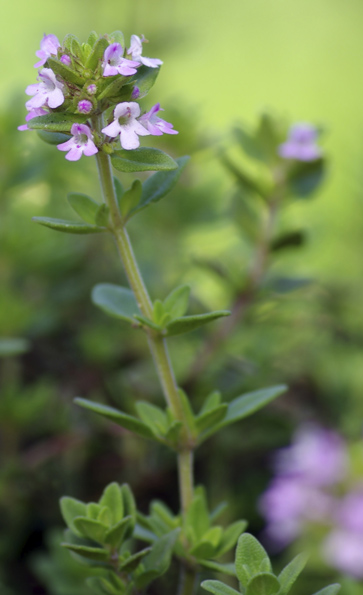
I am pretty sure most people don’t have this herb in their kitchen, but I am positively sure I know the reason why, it’s because they haven’t found out that thyme is one of the most chivalrous herb of them all. Its history is, according to Our Herb Garden, filled with knights in shining armour, fairies, courage, sacrifice, smoke and even love potions. But until we get to that, I would like to tell you a little bit about the origin of this herb, the same source mentions that the name comes from the Greek thumos and/or the Latin fumus which both mean smoke and another theory on thyme history refers to Tournefort (1656 – 1708), who says that the name thyme comes ‘from the mind’ because it was used as a treatment for fainting. Like with all herbs and plants, its first usage was medicinal, even more, the oldest report of thyme use is apparently in the Ebers Papyrus, from ancient Egypt about 1550 BCE where it was used medicinally. (Keeler, “Plant Story.”)
The presence of this herb in history and folklore is even richer, according to the same source listed above, it even contains Biblical references, the manger where Mary gave birth to the infant Jesus, was said to have included thyme, woodroof, and groundsel, so it is a women’s herb and due to its antiseptic properties it was often placed around those about to give birth.
Going to medieval times, thyme was a symbol of bravery and courage and ladies ‘would embroider a motif of a bee hovering over a sprig of thyme on the token they would give to their favoured knight.’ (qtd. in “Thyme Travel: History of Za’atar”) Still in the same period the thyme was used as herb for purifying a space in order to prepare for magical rituals and most often it included fairies. Moreover, according to Danish and German folklore fairies prefer to dwell around patches of wild thyme and this herb can be used to make an ointment which allows anyone to actually see fairies, but this is possible only if thyme was gathered “neare the side of a hill where fayries used to be.”( qtd. in “Thyme.” Our Herb Garden). The link between thyme and fairies is even stronger since William Shakespeare included it in A Midsummer Night’s Dream as a place where Fairy Queen Titania sleeps, clearly marking it as a preferred spot:

‘I know a bank where the wild thyme blows,
Where oxlips and the nodding violet grows,
Quite over-canopied with luscious woodbine,
With sweet musk-roses and with eglantine:
There sleeps Titania sometime of the night,’
(Shakespeare, A Midsummer Night’s Dream, 20)
Scottish tales contain plenty of references to fairies and their deeds. Sorche Nic Leodhas tells the story of young princesses and lords in his book entitled Thistle and Thyme – the first is a symbol of Scottish lands and the latter an indication towards the presence of fairies. In his book of legends and tales he tells the story of the daughter of a lord who wants to marry a shoemaker’s son. In her attempt to marry the man she loves a fairy aids her and the creature is introduced in correlation to the place fairies like to dwell, ‘she came upon a wee small old man sitting on the bank at the side of the lane with his head in his hands’ (Thistle and Thyme, 21). In Norwegian tales thyme is not linked to fairies, but trolls, Redfox and Askeladden (“Redfox and Askeladden.”) tells us the story of Askeladden, a peasant’s boy who saves the daughters of the king from a troll by learning that he is afraid of thyme. He protects his lands by spreading thyme and using an ointment with this herb on all the animals. Later in the story Askeladden kills the troll after strapping him on a pole with thyme.
As said above, thyme is also an ingredient when making a love potion, according to Our Herb Garden on St. Luke’s Day, October 18th, young girls are to do the following:
“Take marigold flowers, a sprig of marjoram, thyme, and a little wormwood; dry them before a fire, rub them to powder, then sift it through a fine piece of lawn; simmer these with a small quantity of virgin honey, in white vinegar, over a slow fire; with this anoint your stomach, breasts, and lips, lying down, and repeat these words thrice:
‘St Luke, St. Luke, be kind to me,
In dream let me my true love see!’
This said, hasten to sleep, and in the soft slumbers of night’s repose, the very man whom you shall marry shall appear before you.” (qtd. in “Thyme.” Our Herb Garden)
This herb has made the crossing from medicinal use into literature to signify force, strength and a repellent agent for evil creatures. Its significance changes according to the region and writer, but it still remains a symbol for courage.
Laven’ der story
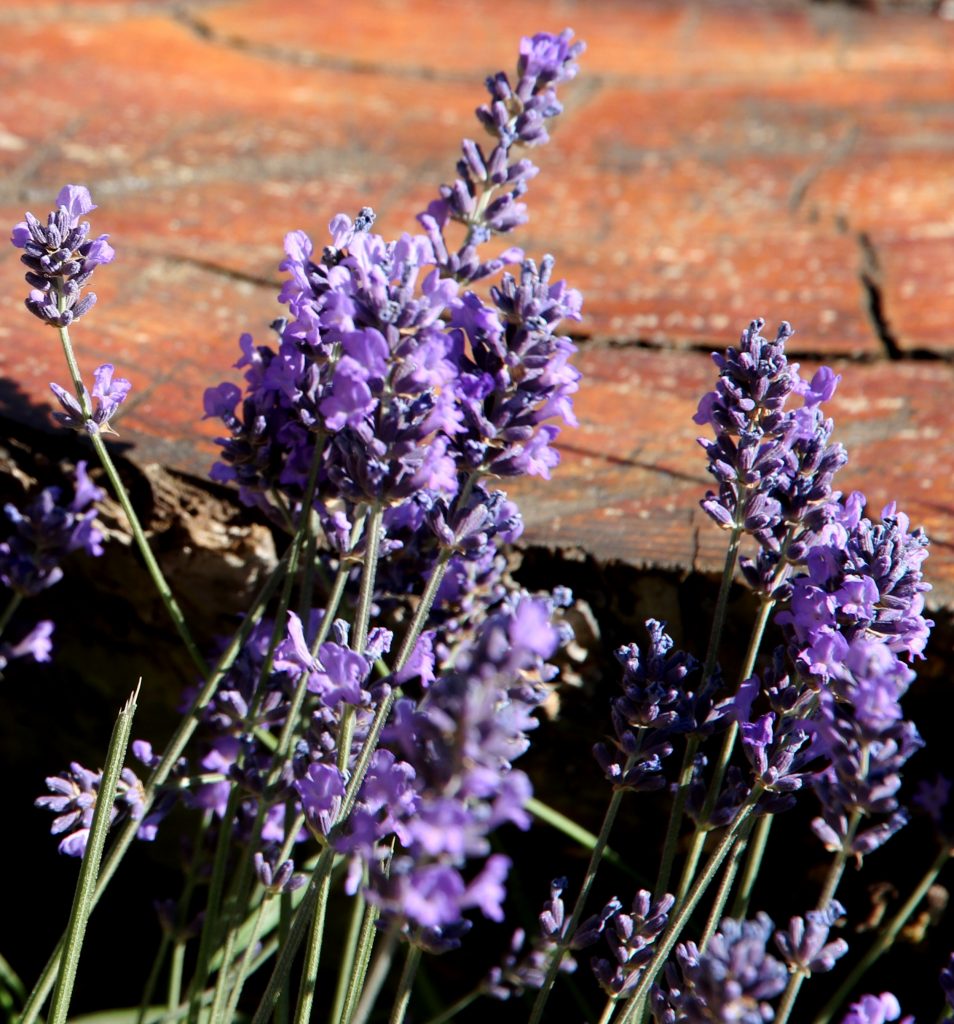

I think there is no other plant more loved and esteemed that lavender, partly due to its antiseptic and health benefits and partly due to its sweet scent. But this plant has a controversial past since it was often confused with nard, because of its powerful scent and resemblance. According to Our Herb Garden, its original name was spikenard and it was later changed into lavender from the Latin term lavare, to wash, because in Ancient Rome, people would use this plant in their bath to scent the water (“Lavender,” Our Herb Garden). But according to the same source, there is another explanation for the change in name, Turner says in his work A New Herball (mid 1500s) that this plant was used to wash the head of a person suffering from a mental disease. Another popular belief tells the story of young ladies being ready for marriage when they sew their own clothes and store them with lavender bouquets.
Throughout history the presence of this plant is undisputable, although it suffered many changes in name. It the beginning it was called Nardus because it was mainly sold in a city from Syria called Naarda. Later we discover a Biblical representation, it is said that Mary Magdeline used spikenard oil (possibly it referred to lavender not nard) to anoint the feet of Jesus. Going to Egypt, King Tutankhamen’s tomb was sealed with lavender inside and upon reopening, it still kept some of its fragrance. When this plant was brought to England (in the 12th century), it rapidly became popular, it is said that Queen Elizabeth I preferred this plant in a special conserve made with lavender flowers. Moreover, according to Our Herb Garden, when the plague hit, a concoction was made called Four Thieves Vinegar that contained lavender as a main ingredient (perhaps to mask the scent of garlic and vinegar) and it was said that it could protect people from this terrible disease (“Lavender – Part 2” Our Herb Garden).
It comes as natural for this plant to be mentioned in literature, William Shakespeare mentions lavender in his play Winter’s Tale, (published in 1623) in act IV, scene 4, when describing a summer’s garden and the art nature has created with them:
”Here’s flowers for you;
Hot lavender, mints savoury, marjoram;”
(Shakespeare, “Winter’s Tale”)
Even Victorian poets have a preference for this plant, Alfred Lord Tennyson mentions lavender in his poem Ode to Memory, published in the first volume of Poems (1842) to signify the beauty of nature that is lost to the passing of time, its beauty remaining only in the memory of people:
‘Of crowned lilies, standing near
Purple-spiked lavender:
Whither in after life retired
From brawling storms,
From weary wind,
With youthful fancy re-inspired’
(Tennyson, “Ode to Memory”)
In prose lavender is mentioned in Miguel de Cervantes’ Don Quixote as an expression to signify that he will face all the battles: ‘it is not to a wedding we are bound, but to go round the world, and play at give and take with giants and dragons and monsters, and hear hissing and roaring and bellowing and howling; and even all this would be lavender, if we had not to reckon with Yanguesans and enchanted Moors.’ (Cervantes, Don Quixote,845)
But the greatest significance of this plant is correlated with love. According to folklore (“Lavender – Part 2.Our Herb Garden), to offer or receive lavender was a symbol of devotion and couples would place lavender under the bed sheets in order to inspire conjugal passion. But there is also a contradiction, lavender used in combination with rosemary can preserve virtue. But the greatest saying tells us more, if a young woman wants to know who her true love is, she should drink lavender tea on St. Luke’s day, the 18th of October, so this saying comes as an addition to the thyme anointment.
Going third basil
I would dare say that today few people use basil in their kitchen, it really isn’t such a popular plant, although herb encyclopaedias note (“Basil.” Herbal Encyclopedia) that it has plenty medicinal benefits, such as relieving headaches, sore throats, coughs, nausea and it can even decrease nervous tension. Basil belongs to the Lamiaceae family (mints), so it’s useful with digestive problems and it also has antibacterial properties. But this herb had so more much significance in the past. According to Lauren Holtfor the Greeks and the Romans basil meant hatred, but later on, for Italians, this herb was associated with love. In the Middle Ages it was thought that scorpions and worms are conjured from basil leaves. Moreover, in the 1500s it was believed that simply smelling basil would breed scorpions of the mind (Milner, “Basil”). But this different symbolism is somewhat explained in the Victorian era when common basil was associated with hatred and sweet basil with love. This herb also carries biblical references, it is said that basil grew at the site of Chris’s crucifixion as a symbol of purification, protection and love. Sicilian folklore associates basil with both love and death and in Moldavia if a man accepts basil from a woman, he will fall in love with her. So we can see that its presence in folklore is vast and it carried various meanings throughout time.
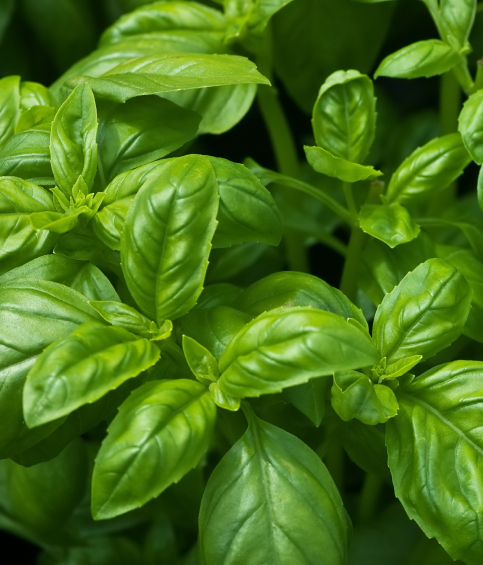
In literature, the most representative work that mentions basil is Isabella or the Pot of Basil by John Keats, published in 1820 (“Isabella annotated”), a narrative poem adapted from a story in Boccacio’s Decameron (IV, 5). This poem tells of the tragic love story between Lorenzo, of the working class and Isabella of upper social strata, so they can never be together. After Lorenzo is killed by her brothers, he shows up in her dreams and asks her to find his body. After she discovers him she buries him in a pot and plants basil to signify her eternal love for him:
‘She wrapp’d it up; and for its tomb did choose
A garden-pot, wherein she laid it by,
And cover’d it with mould, and o’er it set
Sweet Basil, which her tears kept ever wet.’
(Keats, Isabella or the Pot of Basil)
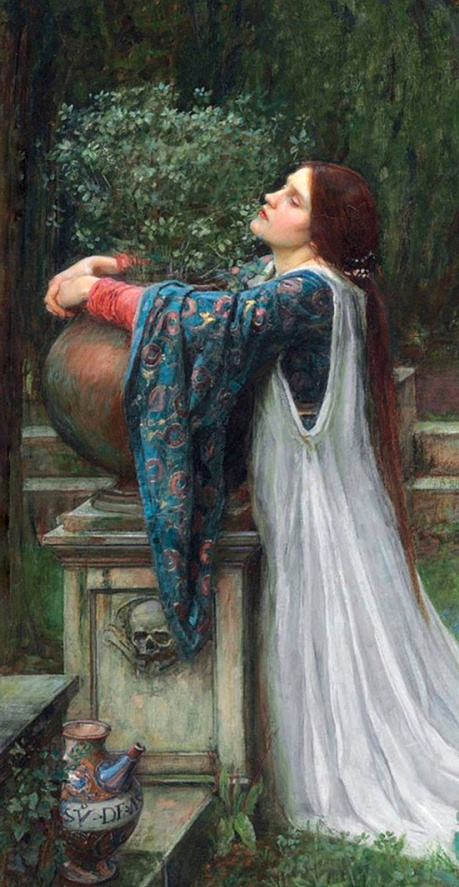
Basil is also extremely important in witchcraft and this herb can help in many situations, starting from money making and ending with alienating a loved one. For example, in order to bring financial wealth into your life, you should ‘Spring dried basil near your desk or tie it in a drawstring bag with some pennies to draw luck to your money and business matters. Refresh before important meetings, phone calls or as needed.’ (qtd. in “10 Ways to Use Basil.” Moody Moons)
As we can see, basil had a controversial past, ranging in significance from love to hatred, but it still remains an important herb, present in folklore with different meanings and in literature as a sign of love.
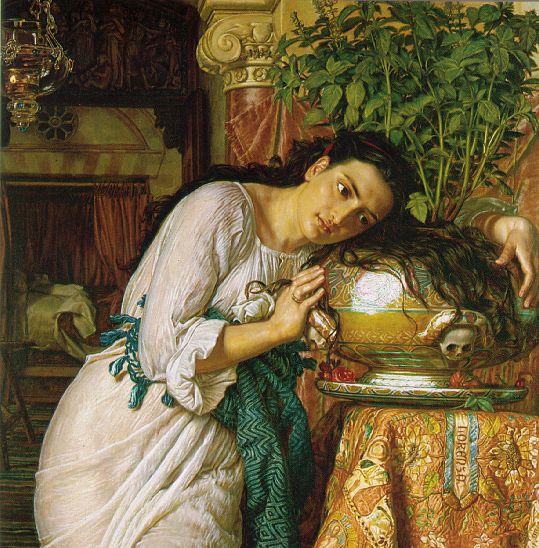
Works Cited
“10 Ways to Use Basil in Witchcraft.” Moody Moons, May 22, 2018. https://moodymoons.com/2018/05/22/10-magical-ways-to-use-basil-in-witchcraft/. Accessed 4 June, 2019.
“Basil.” Herbal Encyclopedia, Common Medicinal Herbs For Natural Health. 2019. https://www.cloverleaffarmherbs.com/basil/. Accessed 4 June, 2019.
“Lavender – Part 2.” Our Herb Garden. 2019. http://www.ourherbgarden.com/herb-history/lavender-part2.html. Accessed 29 May, 2019.
“Lavender.” Our Herb Garden. 2019. http://www.ourherbgarden.com/herb-history/thyme.html. Accessed 29 May, 2019.
“Redfox and Askeladden”. Norwegian Folktales. Posted by Simon Roy Hughes, May 1, 2017. https://norwegianfolktales.blogspot.com/2017/05/redfox-and-askeladden.html. Accessed 28 May 2019.
“Thyme Travel: History of Za’atar.” Za’atar. https://www.zandzdc.com/thyme-travel. Accessed 28 May, 2019.
“Thyme.” Our Herb Garden. 2019. http://www.ourherbgarden.com/herb-history/thyme.html. Accessed 28 May, 2019.
de Cervantes, Miguel. Don Quixote. Translated by John Ormsby, pp. 845. http://pinkmonkey.com/dl/library1/book0530.pdf. Accessed 4 June, 2019. [Originally published: 1605]
Holt, Lauren. “Basil: Herbal Lore and Legends”, Mother Earth Living. July 12. 2010. https://www.motherearthliving.com/natural-health/basil-herbal-lore-and-legends). Accessed 4 June, 2019.
Keats, John. “Isabella, Or the Pot of Basil.” [annotated]. Genius. 2019.https://genius.com/John-keats-isabella-or-the-pot-of-basil-annotated. Accessed 4 June, 2019. [Originally published: 1820]
Keeler, Kathy. “Plant Story–Thyme and Its Folklore.” A Wandering Botanist. July 31, 2016. http://khkeeler.blogspot.com/2016/07/plant-story-thyme-and-its-folklore.html. Accessed 28 May, 2019.
Milner, Conan. “Basil: Herb of Scorpions, Doctors, and Kings.” The Epoch Times. August 16, 2015. https://www.theepochtimes.com/basil-herb-of-scorpions-doctors-and-kings_1710719.html. Accessed 4 June, 2019.
Shakespeare, William. “A Midsummer Night’s Dream.” Edited by K. Dreighton, London/New York, 1891. https://archive.org/details/shakespeareamid00dreigoog/page/n7. Accessed 28 May, 2019. [Originally published: 1600]
Shakespeare, William. Winter’s Tale. The Complete Works of William Shakespeare. 2019.http://shakespeare.mit.edu/winters_tale/full.html . Accessed 4 June, 2019. [Originally published: 1623]
Tennyson, Alfred Lord. “Ode to Memory”. All Poetry. 2019. https://allpoetry.com/Ode-to-Memory. Accessed 4 June, 2019. [Originally published: 1623]
Dania Berinde

